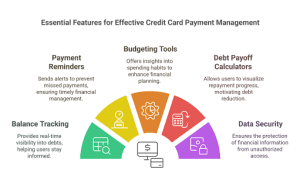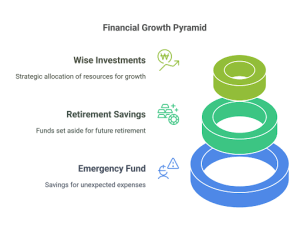Do you feel bogged down with your credit card debt? You are not alone; millions of other Americans are caught in the predicaments of rapidly growing credit card balances. Managing credit card debt is necessary on your way to financial independence, and the right mix of tools and strategies makes all the difference. This blog reviews practical ways to have a say in personal finance using credit card payment trackers. We will discuss tried and tested plans for repayment of debt. It ranges from familiarizing oneself with the debt landscape to related applications incorporated into holistic finance planning. Thus, we have covered you all through the processes.
II. Understanding Your Debt Landscape
Why Is Awareness Important?
Knowing where one stands on one’s financial condition is the first step to effectively managing debt. Here is where it matters:
- Keep Track of Your Balances: By keeping track of your credit card balance, you are aware of how much you need to pay back.
- Decision-Making: If you understand accurately how much you owe, at what interest rate, and when your payments are due, you can prioritize repayment.
Common Types of Debt
Most importantly, it is necessary to differentiate debts. Credit card debts tend to be among the highest-rate debts, while other debts like student loans and mortgages usually have lower rates but are stretched longer through a repayment period. Tailoring the plan of action around the kind of debt warrants ensuring the most favorable outcome.
| Type of Debt | Example | Key Challenge |
| Credit Card Debt | High-interest credit cards | High monthly interest |
| Student Loan Debt | Federal/private loans | Long repayment period |
| Medical Debt | Hospital/health bills | Unexpected expenses |
| Mortgage Debt | Home loans | Tied to property market |
The Emotional Impact of Debt
Debt can lead to stress, anxiety, and even shame, all of which may hinder your progress. Recognizing these emotions and addressing them through mindful financial practices is vital to regaining control.
III. Credit Card Payment Tracking Apps: Your Financial Command Center Trackers for credit card payments make it so easy to track your balances and payments that you can easily track this crucial information about your finances. Another type of application called consolidated debt software can further help you regulate your finances even better as it can scale down your multiple debts into a single manageable payment.
Credit Card Payment Tracking Apps: Your Financial Command Center
Your Financial Command Center Trackers for credit card payments make it so easy to track your balances and payments that you can easily track this crucial information about your finances. Another type of application called consolidate debt app software can further help you regulate your finances even better as it can scale down your multiple debts into a single manageable payment.
What Are Credit Card Payment Tracking Apps?
These apps serve as your financial command center. They track:
- Balances across multiple credit cards.
- Due dates to avoid late fees.
- Spending habits to highlight areas for improvement.
Key Features to Look For
When choosing a credit card payment tracker, these features should be a priority:
- Balance Tracking: View your debts as they stand in real-time.
- Payment Reminders: Alerts that help you avoid any missed payments.
- Budgeting Tools: How-to view on spending patterns.
- Debt Payoff Calculators: See how far you must go to pay it off.
- Data Security: Ensure that your financial information is secure.

Top 5 Credit Card Payment Tracker Apps
Here are some of the best apps to streamline your debt management:
| App Name | USP | Link |
| Mint | All-in-one financial tracker with budgeting, debt tracking, and reminders. | Mint |
| You Need a Budget (YNAB) | Helps users build proactive budgets to eliminate debt effectively. | YNAB |
| Tally | Automates payments and optimizes credit card repayment to reduce interest. | Tally |
| Credit Karma | Tracks credit scores alongside credit card balances and offers free insights. | Credit Karma |
| PocketGuard | Simplifies budgeting and highlights funds available for debt repayment. | PocketGuard |
The Difference Between Free and Paid Options
- Free applications: Suitable for limited tracking but with ads or restricted features.
- Paid applications: More fully featured with options for custom budgeting and in-depth analysis.
Information Security and Privacy
Always opt for apps with strong encryption and accessible privacy policies. Applications like Tally and Mint utilize bank-level security to forfeit user data.
Graph: Key Features Comparison
Here’s a comparison of popular apps:
| App | Free Version | Budgeting | Payment Reminders | Debt Payoff Tools | Security Level |
| Mint | Yes | Yes | Yes | Yes | Bank-level |
| YNAB | No | Yes | Yes | Yes | High |
| Tally | Yes | Limited | Yes | Advanced | Bank-level |
| Credit Karma | Yes | Yes | Yes | Limited | High |
| PocketGuard | Yes | Yes | Yes | Limited | High |
 Mastering Debt Payoff Strategies
Mastering Debt Payoff Strategies
The Importance of a Strategy
Effective debt repayment requires a structured approach. It’s not just about paying what you can—it’s about maximizing impact.
Popular Debt Payoff Methods
- Debt Snowball Method: Focus on paying off the smallest balance first. Gain psychological momentum as you tackle more significant debts.
- Debt Avalanche Method: Pay off high-interest debts first. Save money in the long term by reducing interest.
Table: Example of Debt Snowball vs. Debt Avalanche
| Debt Type | Balance | Interest Rate | Snowball Order | Avalanche Order |
| Credit Card A | $500 | 18% | 1 | 2 |
| Credit Card B | $1,000 | 22% | 2 | 1 |
| Student Loan | $5,000 | 6% | 3 | 3 |
Debt Payoff Calculators and Apps
Apps like Tally and YNAB include built-in calculators that:
- Provide debt-free timelines.
- Visualize your progress.
- Adjust plans based on changing circumstances.
Debt Consolidation: Simplifying Your Finances
What Is Debt Consolidation?
Debt consolidation is a process involving the combining of two or more debts into one payment. It is usually a specialized type of loan with a lower-than-average interest rate. Benefits include:
- Fewer Accounts: This makes managing a smaller number of accounts easier.
- Reduced Cost Over Time: Getting a lower rate can save you some money.
- Boost Your Credit Score: When you make regular payments.
Options for Debt Consolidation
- Balance transfer credit cards: Offer desirable 0% introductory APR on balances during the first few months.
- Personal loans: With fixed rates and predictable payments.
Other programs include Tally and Myfico, each offering a customized plan for debt consolidation.
Beyond Apps: A Holistic Approach to Debt Management
Financial Literacy
While apps offer pros, it is critical to understand relevant fundamentals such as managing a budget, saving, and understanding interest rate charges. One particular site providing free help with financial literacy is MyMoney.gov.
Creating a Budget
Use the simple formula: Income—Expenses = Savings/Debt Repayment. Track your expenses through apps or a simple spreadsheet.
Alternatives to Technology
Some would cringe at so-called hi-tech inhibitory solutions like envelopes. While not automatable or having detailed insights, they genuinely allow for individual involvement.
Long-Term Financial Planning
Once you even start paying down your debts, there are a lot bigger things you can incorporate your efforts into, including:
- Setting up an emergency funds plan.
- Preparing for retirement.
- Optimizing your investments.
 Staying Debt-Free
Staying Debt-Free
Tips for Maintaining a Debt-Free Lifestyle
- Responsible Credit Card Use: Avoid overspending and pay your balance in full monthly.
- Emergency Savings: Set aside at least 3-6 months of expenses.
- Budget Regularly: Reassess your finances periodically.
Graph: Debt-Free Budget Allocation Example
| Category | Percentage |
| Savings | 20% |
| Living Expenses | 50% |
| Entertainment/Leisure | 10% |
| Debt Repayment | 20% |
Conclusion
Managing credit card debt is not childlike; however, it can be achievable with a proper strategic approach. Understand your debt landscape very well, use credit card payment trackers like Mint or Tally, and maintain stringent repayment strategies to achieve financial freedom.
Take the first step today: choose a credit card payment tracker, create a plan, and commit to a debt-free future. Have questions? Leave a comment below or explore more posts on financial wellness.

























